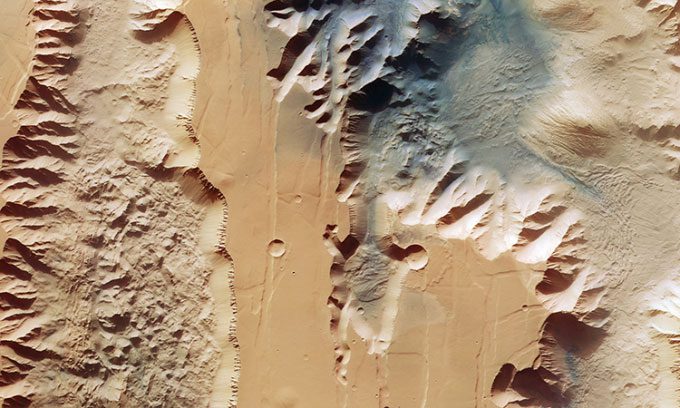The European Space Agency (ESA) spacecraft has sent back images of the 4,000 km long Valles Marineris canyon system on Mars.

Ius and Tithonium Chasmata canyons in the massive Valles Marineris system on Mars. (Image: ESA/DLR/FU Berlin)
The Mars Express spacecraft from the European Space Agency (ESA) captured images of the large cracks in the Martian crust, part of the 4,000 km long Valles Marineris canyon system. The images taken on April 21 and released by ESA on July 20 clearly show the Ius and Tithonium Chasmata canyons located in the western part of the canyon system.
Ius Chasma is on the left, stretching 840 km, while Tithonium Chasma is on the right, extending over 805 km. With a depth of 7 km, these canyons could almost swallow the highest mountain on Earth, Mount Everest. In contrast, the deepest point of the Grand Canyon, the famous canyon in the United States, is just over 1.6 km.
Valles Marineris is the largest canyon system in the Solar System. If it were transferred to Earth, this structure would stretch from northern Norway to Sicily in southern Italy. Valles Marineris is ten times longer, twenty times wider, and about five times deeper than the Grand Canyon.
The new images highlight signs of landslides, dark sand dunes, earth mounds the size of mountains eroded by wind, and smaller mounds that may be related to ancient water evaporation processes.
Unlike the Grand Canyon, Valles Marineris was not formed by river erosion. Some evidence of the period when this canyon system formed can be observed at the bottom of Ius Chasma. “As the tectonic plates drifted apart, they seemed to have created jagged triangular rock formations resembling shark teeth. Over time, these rock structures collapsed and eroded,” ESA stated.
Valles Marineris is an intriguing structure not only because of its size and appearance. ESA has found evidence of frozen water there. In the future, if humans can reach Mars, they will need to utilize the available water resources on this planet, especially if they intend to stay for an extended period.




















































